
|
KDE 3.1 New Feature Guide
With the KDE Project announcing the release of KDE 3.1 today, the burning question on everyone's mind is, "What's new in it for me?" KDE 3.1, easily the strongest Open Source desktop ever to ship, offers a bountiful basket of new goodies for just about everyone. Read on and explore the exciting new features and applications that the new KDE 3.1 offers you!
Index
- Personal Information Management
- Enterprise Integration
- Browsing
- Eye Candy
- Multimedia / Graphics
- The Desktop
- Edutainment / Games
- Under the Hood
- Administration
- Development / Internationalization
- More Information / Some KDE Stats
Personal Information Management
Email Security.
On the PIM front, the email client
(KMail)
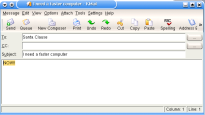 has gained several important privacy and security enhancements -
namely S/MIME, PGP/MIME and X.509v3 support. This work has been done
in successful collaboration with the
Ägypten project,
an IT security project being
developed
under contract by the German government
(screenshot).
Moreover, OpenPGP support has been
enhanced, such as enabling encrypting with a different key for each
addressee.
has gained several important privacy and security enhancements -
namely S/MIME, PGP/MIME and X.509v3 support. This work has been done
in successful collaboration with the
Ägypten project,
an IT security project being
developed
under contract by the German government
(screenshot).
Moreover, OpenPGP support has been
enhanced, such as enabling encrypting with a different key for each
addressee.
Calendar Exchange Integration.
The calendar / scheduling application
(KOrganizer) features
a number of compatibility and feature improvements:
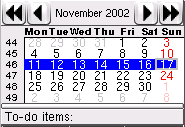
-
A new plugin for accessing calendar data from an Exchange 2000 server,
-
Support for iMIP, an industry standard used by Outlook, Lotus Notes and Evolution) integration, including group-scheduling functions for todos and events.
-
Improved support for the industry-standard iCalendar calendaring and scheduling protocol.
-
Improved KDE address book integration (screenshot).
-
Customizable templates for events and todos and alarms for todos.
Address Book Standards with LDAP and vCard. The address book library (libkabc), used throughout KDE, has a number of important improvements:
-
A new control module for configuring multiple resources, including the industry-standard LDAP resources.
-
An LDAP-aware email address input field.
-
Complete support for the industry-standard vCard, as well as new vCard 2.1 import.
-
A new versatile plugin mechanism.
-
An optional binary database format for quick access to large address books.
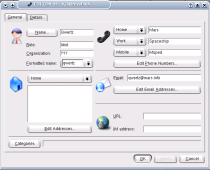
The principal address book application (KAddressbook) has
gained the ability to fetch contact information from one or more
LDAP servers, print contact information, access multiple address books,
and import / export of industry-standard vCards
(screenshot).
In addition, the user interface has received a number of usability
enhancements, such as a "jump bar" for quick alphabetized access to
entries and entry categories.
Palm Integration. The Palm OS-based PDA integration (KPilot) provides a number of new conduits, including Time, AvantGo and new KDE address book (KAddressBook) conduits.
Looking Ahead.
While not included in the 3.1 release,
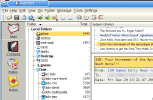 the next quantum jump in KDE's
email / groupware architecture is scheduled for KDE 3.2,
when a completely copy-lefted, integrated groupware system is scheduled
to ship with KDE.
Named Kontact
(screenshot), the project will integrate the major
KDE PIM applications,
and also incorporate the achievements of the
Kroupware project. Kroupware,
which is being developed under contract with an agency of the German government,
aims "to provide a Free Software groupware solution accessible with Windows
running Outlook and GNU/Linux running KDE clients."
More about this project, and some additional screenshots, can be found on
dotsy, the KDE news
site.
the next quantum jump in KDE's
email / groupware architecture is scheduled for KDE 3.2,
when a completely copy-lefted, integrated groupware system is scheduled
to ship with KDE.
Named Kontact
(screenshot), the project will integrate the major
KDE PIM applications,
and also incorporate the achievements of the
Kroupware project. Kroupware,
which is being developed under contract with an agency of the German government,
aims "to provide a Free Software groupware solution accessible with Windows
running Outlook and GNU/Linux running KDE clients."
More about this project, and some additional screenshots, can be found on
dotsy, the KDE news
site.
Enterprise Integration
Lock-Down. KDE 3.1 gives birth to the new lock-down framework, which is essentially a permissions-based system for managing application configuration options. Enterprises, Internet cafes and similar users will appreciate enhancements to the KDE "Kiosk" framework, which provides a simple way to disable certain features within KDE to create a more controlled environment. For example, a system administrator can preclude users from modifying desktop wallpapers or changing the start menu entries. Implementing this framework currently requires modifying some simple text files, though KDE 3.2 is scheduled to provide a user-friendly GUI to manage these tasks.
Basic support for this feature already exists in KDE. Based on feedback received, the plan is to complete this framework in KDE 3.2.
 Desktop Sharing.
For those who switch work stations frequently, KDE offers
a new VNC-compatible
desktop sharing framework (KRfb, KRdc).
For KDE 3.1 it is mainly intended for remote
technical support or showing off your desktop to other users, with the
ability of the remote user to see as well as control the desktop;
but with KDE 3.2 it will empower KDE users to share their
desktop across multiple machines on a heterogneous network
(screenshot).*
Desktop Sharing.
For those who switch work stations frequently, KDE offers
a new VNC-compatible
desktop sharing framework (KRfb, KRdc).
For KDE 3.1 it is mainly intended for remote
technical support or showing off your desktop to other users, with the
ability of the remote user to see as well as control the desktop;
but with KDE 3.2 it will empower KDE users to share their
desktop across multiple machines on a heterogneous network
(screenshot).*
Panel Customizations. In addition, the panel (Kicker) now supports fully customized menus.
Browsing
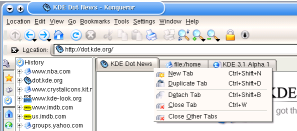 Tabbed Browsing.
The many fans of tabbed browsing will be delighted by this
latest enhancement to the KDE web browser
(Konqueror)
(screenshot).
Tabbed Browsing.
The many fans of tabbed browsing will be delighted by this
latest enhancement to the KDE web browser
(Konqueror)
(screenshot).
Session Management.
For the occassions when a browsing session ends abruptly, a
new session recovery plugin will help restore the complete
session upon recovery.
Download Manager.
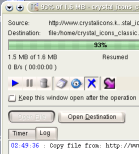 To simplify downloading a large number of files, a new download manager
(KGET)
has joined the network package (kdenetwork).
Similar to GetRight and
Go!Zilla, it manages
any number of downloads in one window. Transfers
can be added, removed, paused, resumed, queued or scheduled, and
transfer lists can be imported / exported.
A dialog displays transfer status, including progress, size, speed and
estimated time to completion. Best of all, it integrates fully into
the KDE web browser and file manager.
To simplify downloading a large number of files, a new download manager
(KGET)
has joined the network package (kdenetwork).
Similar to GetRight and
Go!Zilla, it manages
any number of downloads in one window. Transfers
can be added, removed, paused, resumed, queued or scheduled, and
transfer lists can be imported / exported.
A dialog displays transfer status, including progress, size, speed and
estimated time to completion. Best of all, it integrates fully into
the KDE web browser and file manager.
Secure Remote File Access. Building on KDE's powerful network-transparent data access architecture (KIO), KDE 3.1 provides a new tool (kio_fish) to access remote file systems using the industry-standard secure shell technology. This addition means that every KDE-compliant application can, with the proper authentication, securely and transparently access and modify files located on a remote machine, absent the need to install any special software on the remote machine.
Looking Ahead. Much attention has recently been showered on the KDE HTML rendering engine due to its adoption by Apple in its Safari browser. While some of the efforts of the Safari developers have found their way into KDE 3.1, the vast majority of the Apple developers' performance, rendering and JavaScript improvements which will be incorporated into KHTML are scheduled for release with KDE 3.2.
Eye Candy
The artistically-inclined KDE contributors have showered us with a bounty of new eye candy.
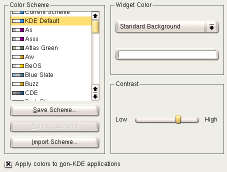 Keramik Style.
KDE 3.1 provides users with a new, completely original widget style.
From buttons to lists and window decorations, Keramik adds a fresh
new look to KDE, highlighting the tremendous progress under the
hood and in the rapidly-expanding application mix ready to
serve KDE users.
Keramik Style.
KDE 3.1 provides users with a new, completely original widget style.
From buttons to lists and window decorations, Keramik adds a fresh
new look to KDE, highlighting the tremendous progress under the
hood and in the rapidly-expanding application mix ready to
serve KDE users.
![]() Crystal Icons (SVG).
As shown in this
screenshot,
KDE 3.1 will ship with the contemporary Crystal icon set as the default
icon theme. Although for this release these icons have been pre-rendered
as PNG images, this very original and stunning icon set is implemented using
the cutting-edge Scalable Vector Graphics (SVG) technology. This technology
will enable rendering these icons at any arbitrary size and color
combinations in future releases. Of course a number of alternative
icon sets, including the prior default hicolor theme, are
available in the expanded KDE artwork package (kdeartwork) and
from the KDE Look website.
Crystal Icons (SVG).
As shown in this
screenshot,
KDE 3.1 will ship with the contemporary Crystal icon set as the default
icon theme. Although for this release these icons have been pre-rendered
as PNG images, this very original and stunning icon set is implemented using
the cutting-edge Scalable Vector Graphics (SVG) technology. This technology
will enable rendering these icons at any arbitrary size and color
combinations in future releases. Of course a number of alternative
icon sets, including the prior default hicolor theme, are
available in the expanded KDE artwork package (kdeartwork) and
from the KDE Look website.
Theme manager. To help manage these new stunning and contemporary themes, KDE will provide a new theme manager with improved theme style and color decoration previews (screenshot).
Miscellaneous. For those with CPU cycles to burn, a variety of new features add to the interactiveness and overall beauty of the desktop. Menus, for instance, can be configured to use attractive drop shadows, as shown in the screenshot above. And panel icons now support mouse-over animations.
Multimedia
Video System. The multimedia framework (kdemultimedia) has a new video decoder based on Xine. Xine is a video framework which provides support for various video formats, such as AVI, DivX, Cinepak, Sorenson Video, MPEG 1/2 and 4, QuickTime / MOV, ASF and others. In addition, a video thumbnail generator has been integrated into the file manager.
Recording. The KDE multimedia system (aRts) provides a number of new recording facilities, including a new CD ripper and audio encoder frontend (KAudioCreator).
Media Player. The media player (Noatun) now provides a lyrics applet for searching lyrics in the current song.
Graphics
Image viewing. The image viwer (KView) has a plugin-architecture for slideshows. Moreover, a number of other improvements, such as complete mouse wheel support, automatic resizing and enhanced printing solidify the capabilties of this desktop component.
The Desktop
File Management. The file manager (Konqueror) offers users a panacopia of new goodies, including folder icons which reflect a folder's contents and a video thumbnail generator.
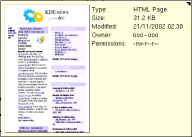 Meta-Data.
As the amount and variety of data we store on our computers increases,
so does the need to be able to search and organize it. KDE 3.1
raises the bar in this front in a number of respects. The
file manager now supports a number of plugins for
creating, editing and/or viewing enhanced- or
meta-information about various file types
(e.g., audio files (such as MP3 IDv3 tags), images,
binary packages, address-book data, emails, video files,
desktop configuration files, and programming data).
This new technology is supplemented with the capability to
search in file meta-information with the file manager's search
utility, thereby enabling searching in multi-media files.
Related enhancements, such as large (256x256) preview icons in
the file manager, accentuate this progress.
Meta-Data.
As the amount and variety of data we store on our computers increases,
so does the need to be able to search and organize it. KDE 3.1
raises the bar in this front in a number of respects. The
file manager now supports a number of plugins for
creating, editing and/or viewing enhanced- or
meta-information about various file types
(e.g., audio files (such as MP3 IDv3 tags), images,
binary packages, address-book data, emails, video files,
desktop configuration files, and programming data).
This new technology is supplemented with the capability to
search in file meta-information with the file manager's search
utility, thereby enabling searching in multi-media files.
Related enhancements, such as large (256x256) preview icons in
the file manager, accentuate this progress.
Event Notification. Two new user notification methods have also been added for providing non-obtrusive informational messages: a passive popup window (KPassivePopup), which pops up next to the application's entry in the panel's taskbar (without stealing the focus), as well as messages which appear in an application's title-bar (KWindowInfo).
Ease of Use. A large number and diverse range of other improvements are simply part of the ongoing effort to make the desktop easier to use and configure. For example, the application finder (KAppfinder) provides a nice tree view for selecting the applications to include in the KDE desktop menu hierarchy. The power of multiple desktops has been made more accessible with the option to switch among desktops using a mouse scroll wheel. The bookmark editor now supports multiple selections. In addition, the KDE Usability Project has contributed a great many usability enhancements for this release.
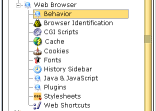 Control Center.
The KDE control center (KControl), the flexible KDE
configuration and information center, has received an important
face lift. The principle improvement: better organization
(screenshot).
Some new modules have joined the framework as well, chief
among them a monitor resolution and gamma correction
tool, and other modules have been improved or redesigned, such as
the font modules. Finally, the user manuals for control center modules
have better integration into the Help Center
(KHelpCenter).
Control Center.
The KDE control center (KControl), the flexible KDE
configuration and information center, has received an important
face lift. The principle improvement: better organization
(screenshot).
Some new modules have joined the framework as well, chief
among them a monitor resolution and gamma correction
tool, and other modules have been improved or redesigned, such as
the font modules. Finally, the user manuals for control center modules
have better integration into the Help Center
(KHelpCenter).
Panel. The desktop panel (Kicker) has gained a number of new features, such as fully customized menus, multiple clocks (for monitoring different time zones) and "smart" grouping in the taskbar.
Edutainment
This release includes the new "Edutainment" package, maintained by the KDE Edutainment Project. A number of additions to this education-oriented package (kdeedu) make their first appearance in KDE.
-
Chemistry: a tool to help students learn the Periodic Table of Elements (Kalzium).
-
Mathematics: a mathematical function plotter with a powerful built-in function parser (KmPlot), and a simple math application that will aid pupils in improving their skills in calculating percentages (KPercentage).
Games
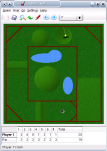 For the playful among us, KDE 3.1 will offer a number of new games in the
optional but fun-filled games package (kdegames).
For the playful among us, KDE 3.1 will offer a number of new games in the
optional but fun-filled games package (kdegames).
Golf. Kolf is a golf game making its debut with KDE 3.1 (screenshot).
 Atlantik.
Inspired by the famous boardwalk in Atlantik City, New Jersey,
the Monopoly-type game
Atlantik,
has joined the games package. Featuring network play and original
board themes, it is sure to provide hours of entertainment
when you cannot meet in person.
Atlantik.
Inspired by the famous boardwalk in Atlantik City, New Jersey,
the Monopoly-type game
Atlantik,
has joined the games package. Featuring network play and original
board themes, it is sure to provide hours of entertainment
when you cannot meet in person.
Misc. Also new in KDE 3.1 is the Blackjack game (Megami). and a Same-like game Klickety.
Under the Hood
Stability. Of course work under the hood continues for KDE 3.1 as well. On the performance front it provides a number of welcome improvements, such as on-demand icon loading for reduced application startu-up times, reduced Konqueror start-up delays, and smarter thumbnail generation. On the stability and consistencey front, the development teams have squashed over 1,000 critters since the much-heralded KDE 3.0 release.
Security. The KDE Project's dedication to providing the latest technologies does not play second fiddle to its dedication to a secure desktop framework. KDE 3.1 fixes all known security problems, having undergone a thorough security review prior to release. The KDE project encourages anyone who discovers security vulnerabilities to report them promptly to the diligent and responsive KDE security team.
Administration
Inter-Process Communication. KDE's IPC mechanism (DCOP) continues to expand its capabilties with this release. An improved command-line client grants access to the widely-used DCOP interface to non-GUI applications, which is particularly useful for desktop scripting using shell scripts, cron jobs and system processes. Furthermore, IPC scalability has grown with the ability to send concurrent messages to multiple users and/or sessions concurrently. This enables, by example, a system administrator to send messages to all users via a dialog or suitable application.
Console. KDE's terminal emulator (Konsole) has undergone improvement in a wide range of areas:
-
New sessions can be started at a bookmarked URL, including URLs such as
ssh://user@hostandtelnet://hostURLs; -
The initial or current directory is saved as part of the session management.
-
Session views can be detached from the main window.
-
Profile saving and management has improved.
-
Added support for Unix98 ptty devices.
-
History searching has improved, including regular expression support.
-
Integrated the file browser's / file dialog's bookmarks.
-
A Copy menu entry for copying to the second clipboard has been added.
-
Keyboard and schema selection has improved.
-
Added graphical shortcut configuration as well as new shortcuts.
-
Disabled control flow (scroll lock) via the
Ctrl-sandCntrl-qcontrol keys by default. -
Extended the drag'n'drop popup menu with the
cp,lnandmvcommand entries.
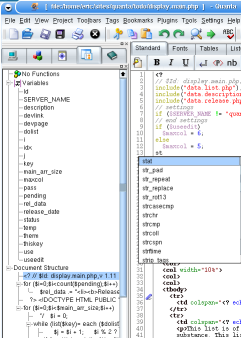
Development
Quanta Plus. For the first time ever KDE ships with a a rapid web development platform (Quanta Plus). Its many features include:
-
Full HTML 4.0, CSS (Cascading Style Sheets) and JavaScript (EMCAScript) support, including DTD management.
-
PHP integration for dynamic web content, including a PHP debugger, syntax highlighter, name-completion and variable / function lists.
-
Templates for files, code and images and drag'n'drop template creation.
-
File and directory uploading and CVS integration.
-
Great customizability and extendability.
Kiosk Mode. As noted above, KDE 3.1 features a greatly enhanced Kiosk framework for managing the configuration options available to users. Included with this framework is a simple application API which applications can query to test authorization for certain operations.

Editor. The developer's editor (Kate) provides improved XML support. Besides improvements to the XML completion plugin, the editor features a new XML checker based on xmllint.
Multimedia.
A new library interface (KMediaPlayer) enables application
developers to incorporate the mini-media player (Kaboodle)
into their application easily.
Internationalization
Translation Tool. The translation tool (KBabel) has improved in a great many respects, principal among these being XML validation and highlighting, a tag structure tool, a rough translation assistant, and multi-file spell checking.
Dates and Times. Date selection now conforms to the ISO 8601 standard for week number display and selection. The first day of the week can now be set to any arbitrary day. And, as noted earlier, the panel supports multiple clocks to enable monitoring multiple timezones.
More Information
A more complete KDE 3.1 "new feature" list is available from the KDE 3.1 ChangeLog page.
Looking toward the future, in addition to a few items of note described earlier, more information about planned KDE 3.2 features is available here.
Some KDE Stats
The KDE CVS source code repository consists of roughly 2.6 million lines of code (LOC). By comparison, the Linux kernel (version 2.5.29) consists of about 3.1 million lines of code. The KDE Project consists of hundreds of active contributors, with 300 of them translating KDE into over 70 languages (KDE 3.0.4 shipped in 51 languages). In May 2002 over 11,014 CVS commits were executed. The KDE website has 24 official mirrors in 16 countries and the KDE FTP site has 71 official mirrors in 30 countries.
Written by Andreas "Dre" Pour for the KDE League, Inc.
Trademarks Notices. KDE, K Desktop Environment, KDevelop and KOffice are trademarks of KDE e.V. AvantGo is a trademark of AvantGo, Inc. Exchange 2000 and Microsoft are registered trademarks, and Exchange and Outlook are trademarks, of Microsoft Corp. in the United States and/or other countries. GetRight is a registered trademark of Headlight Software, Inc. Linux is a registered trademark of Linus Torvalds. Lotus Notes is a registered trademark of IBM-Lotus. Palm is a trademark of 3Com Corporation or its subsidiaries. Trolltech and Qt are trademarks of Trolltech AS. UNIX is a registered trademark of The Open Group in the United States and other countries. All other trademarks, servicemarks, product and service names and copyrights referred to in this announcement are the property of their respective owners.